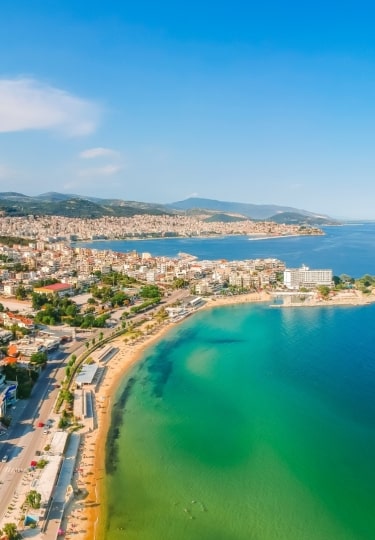Built on a hillside overlooking the Aegean Sea and just a two-hour drive from the Turkish border, Kavala is one of Greece’s most underrated cities. And that’s a real shame, for those who eschew it in favor of more “glamorous” destinations such as Athens, Thessaloniki, or the islands are truly missing out.
Vacation hotspots often claim they offer something for everyone, but few can boast Kavala’s vast array of things to see and do, from mountains to monuments, history, beaches, and incredible cuisine.
So if you’re planning to visit Kavala, the question has to be, how do you get the best out of the city, given it offers so much?
Why Visit Kavala
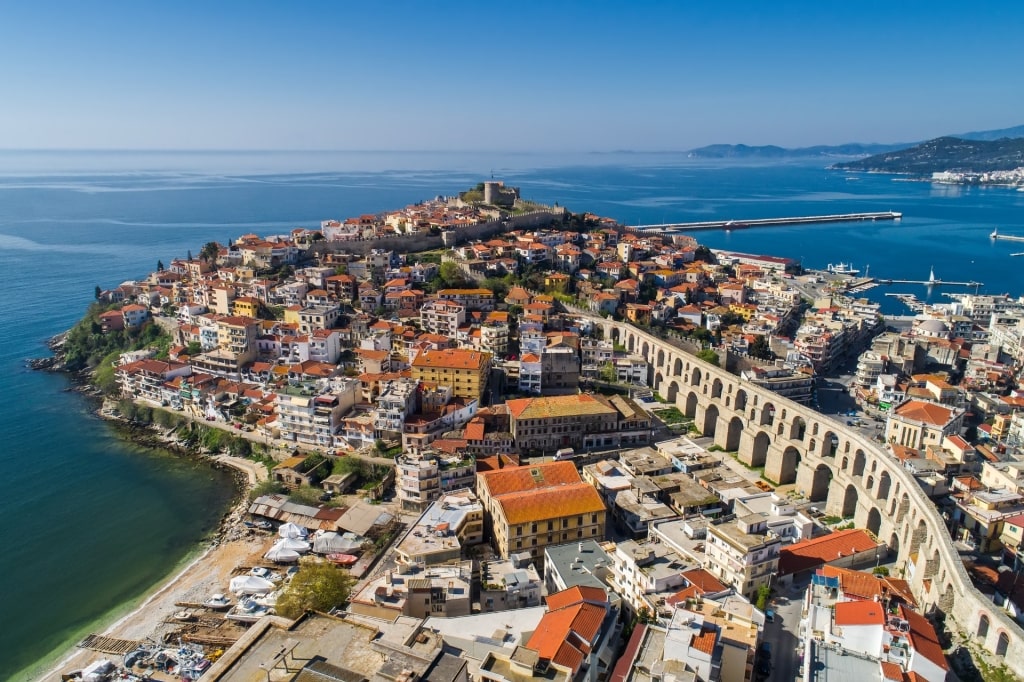
Panagia
Set on Greece’s northern coast between the second city of Thessaloniki and the border with Turkey, for many Kavala may seem like a remote outpost—but that could not be further from the truth.
Founded as early as the seventh century BC and occupied over the years by everyone from the Macedonians and Romans to Ottomans and Bulgarians, Kavala has a long and checkered history that makes it a perfect melting pot of Western and Eastern cultures.
That can be seen in the pretty Old Town of Panagia, set on a hilly peninsula and dominated by a 15th century Greek castle. Its winding streets and brightly colored Macedonian buildings spill down the hill to the port below, the Aegean casting a blue hue all around.
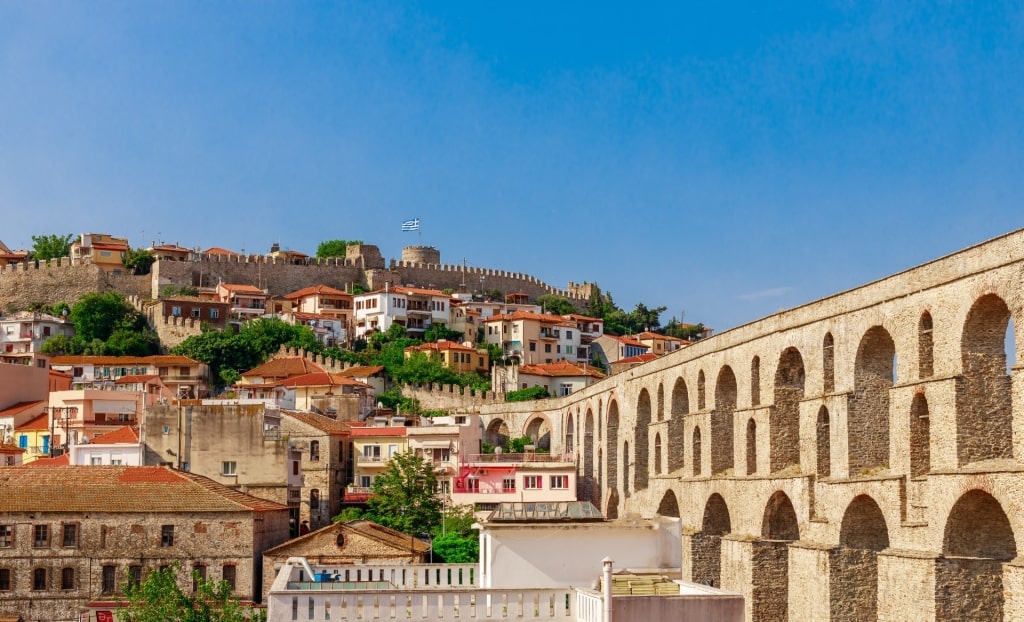
Panagia
This buzzy town center is awash with bars, cafés, and shops selling Greek souvenirs, and punctuated with historic monuments such as the dominating Kamares viaduct, Ottoman mosques, and the famed Mohamed Ali Pasha’s House, the former residence of one of the world’s great generals.
Kavala’s historic wealth as both a merchant naval power and a key center of tobacco production can be seen around the harbor and tobacco warehouses, as well as the elegant 1895 City Hall and the Austrian baroque Great Club of Kavala.
Staying in the center offers enough to do for a week, but there’s natural beauty here, too. You’ll find some of northern Greece’s best beaches, for example. Or take the scenic hike along the Waterway Trail, visit forested Mount Paggeo, and explore the lush region around the Nestos River, a real adventure playground.
History & Culture
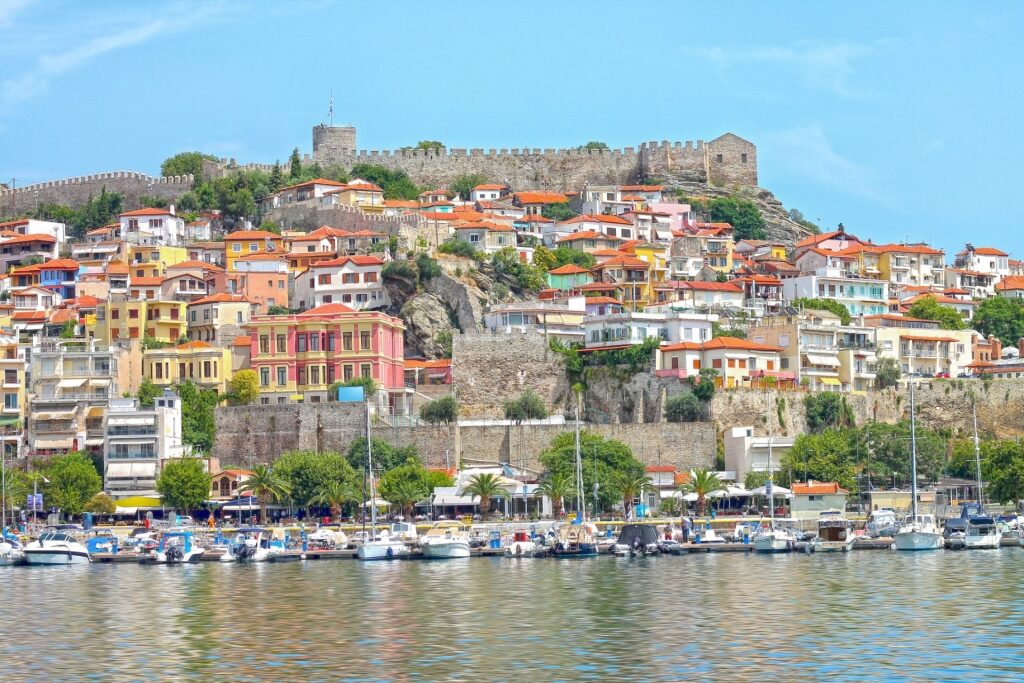
Kavala
Founded in the seventh century BC by settlers from the north Aegean island of Thassos, the location of Neapolis, which means “New City”, as Kavala was then known, was chosen for its strategic coastal position at the crossroads of Europe and Asia.
Nearby gold and silver mines with rich seams saw this Greek city grow in importance as it became a thriving hub for both trade and military activities. It also played a crucial role in the spread of Christianity when the Apostle Paul passed through in AD49 while undertaking his journey as a missionary.
As the city’s fame and fortune grew, it became more coveted by the powers that be, passing from one empire to another. The Romans left behind roads and aqueducts, the Byzantines added fortified walls, and the Ottomans brought their mosques and minarets.
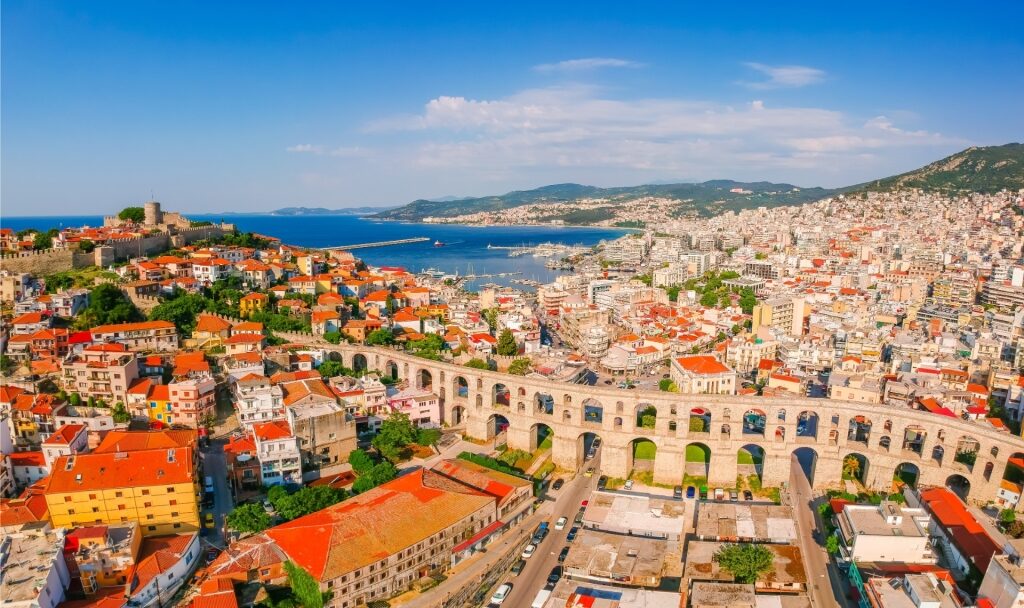
Panagia
Upheaval in the Balkans and a golden era of tobacco production saw Kavala switch hands several times in the late 19th and early 20th centuries. It was finally incorporated into Greece in 1912, although three periods of Bulgarian rule did follow across the two world wars.
Despite its incorporation into Greece, Kavala retains a fiercely independent spirit and in 1934 it elected Greece’s first ever Communist mayor, earning it the nickname “Little Moscow”.
Wildlife & Nature
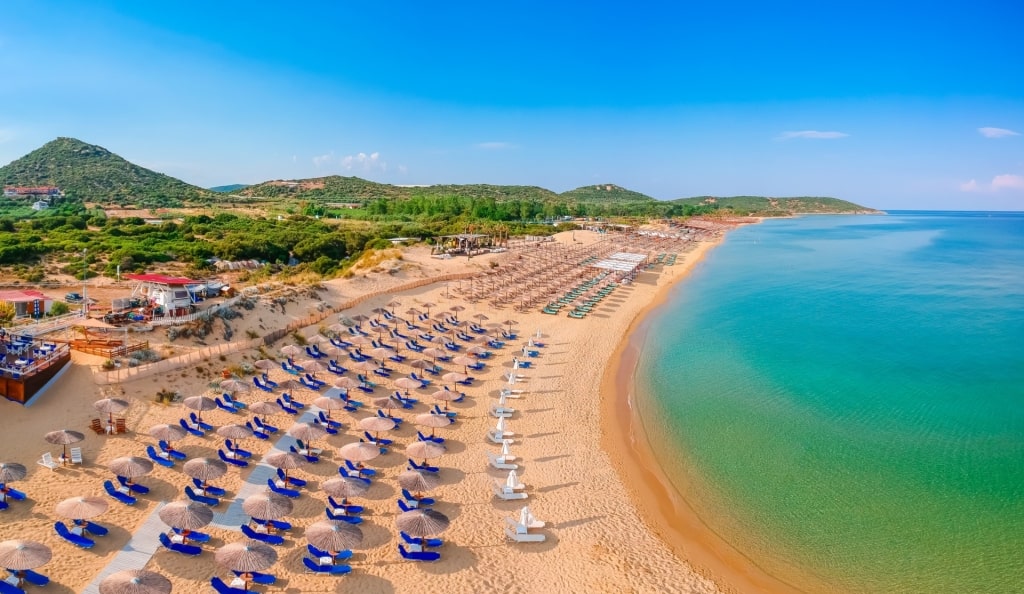
Ammolofi
Kavala is also known as the “Blue City”, a nickname taken from the azure waters that surround the Panagia peninsula, bathing the city in a cyan hue when the sun shines brightest.
The surrounding coastline is equally impressive, switching between craggy coves, low-lying cliffs, and long sandy beaches such as those at Paleo, Nea Iraklitsa, Ammolofi, Vrasida, and more. While many of them are “organized” with umbrellas, lounge chairs, and beach snack bars, each turn in the winding coastal road can reveal a seemingly undiscovered hidden cove or bay.
There’s much to do beyond the beach, too. South of the city lies imposing Mount Paggeo, known for its lush forests, rich biodiversity, and traditional Macedonian-style villages seemingly caught in a timewarp.
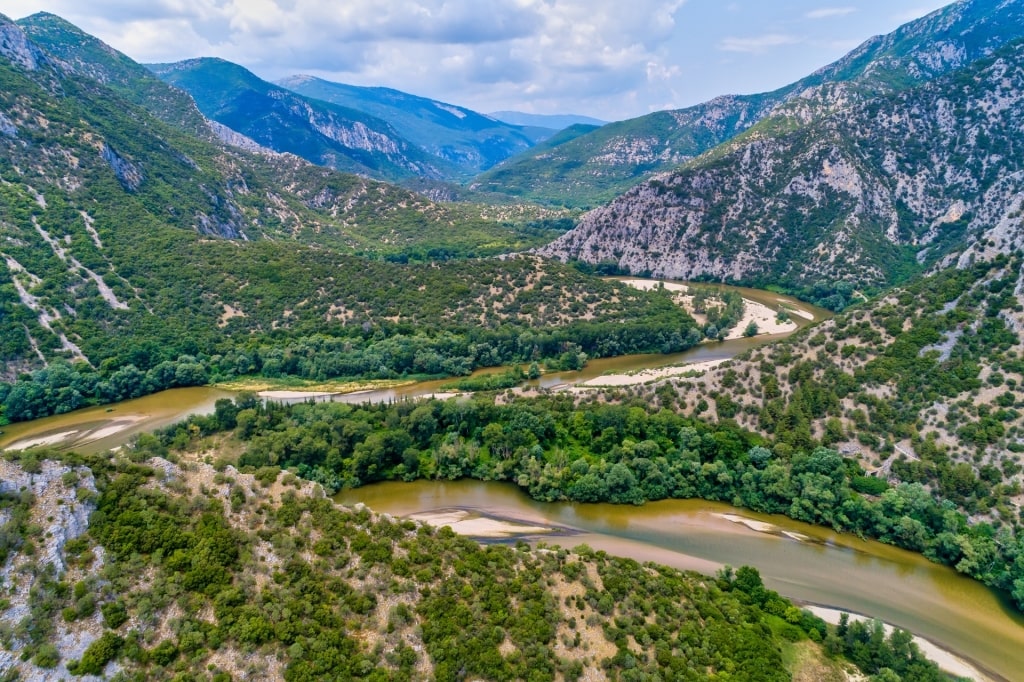
Nestos
Less than 20 miles away is Nestos, a land of lagoons, lakes, green riverbanks, caves, and rocks along the river of the same name. Adventure sports such as river rafting and canyoning abound here.
The Nestos empties into a delta just south of the quaint town of Chrissoupoli forming one of the most important wetlands in both Greece and Europe. This protected area is a haven for birdwatchers as it’s a migratory stopover for many different species.
With such rich biodiversity, there’s the chance to spot all manner of other animals too, from octopuses in the ocean to foxes, hares, and even wild boars in the surrounding forests.
Tips For Visiting Kavala
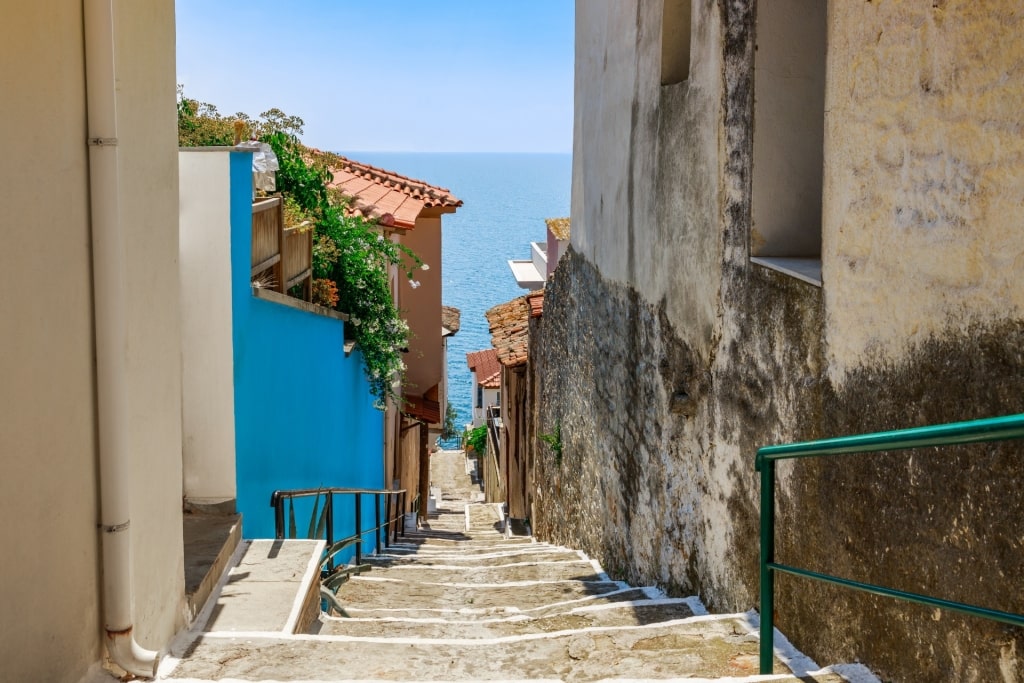
Panagia
The Old Town is incredibly walkable with all the sights in relatively close proximity. If visiting in the height of summer, and particularly if climbing to the fortress, make sure to take shade and water, and to wear comfortable shoes. Afternoons here can be blisteringly hot.
Best, then, to do most of the exploring during the early morning, before taking a leisurely lunch and venturing back out when it cools down a little. Do note that early evening is the time Greeks take their “volta”, or evening walk, usually culminating in a coffee stop. People tend to dress to impress at this time and you don’t want to look out of place.
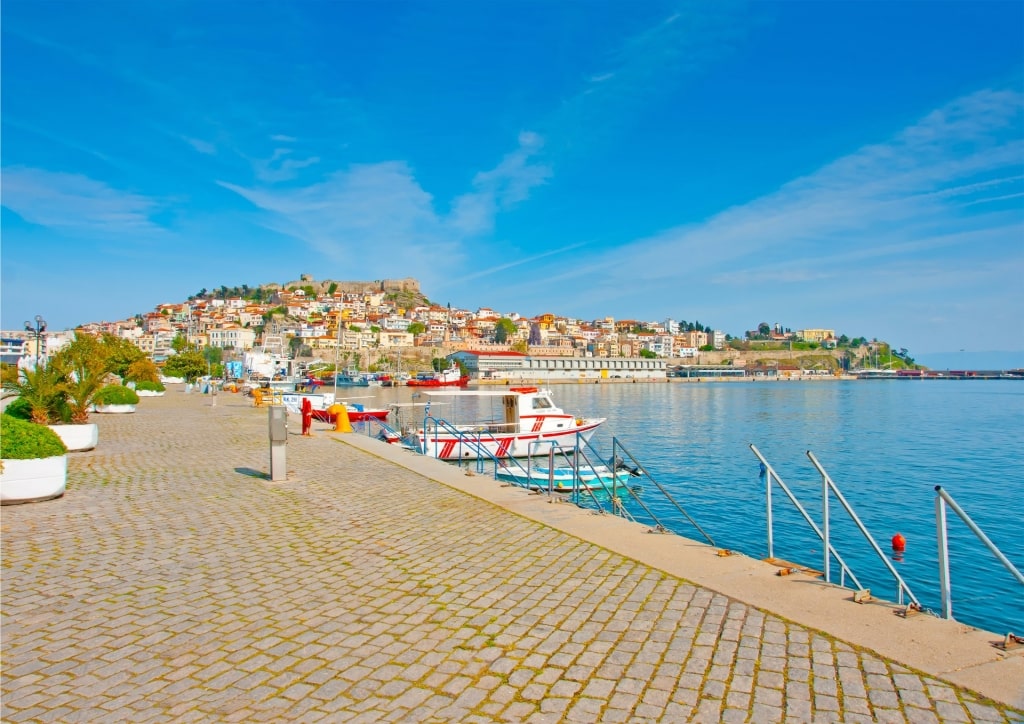
Kavala Port
Remember too that if visiting a church or mosque, it’s polite to cover shoulders and knees, irrespective of gender.
If you want to cool off quickly without spending all day on the surrounding sands, the nearest beach to the Old Town is Rapsani, a few minutes walk to the east of the port.
While almost everyone will speak English on a visit, learning a few words of Greek always helps. At the very least, try to use “parakalo”, which means “please”, and “efharisto”, or “thank you”.

Kourabiedes
Good gifts to take home include local honey, olive oil, and wine, given there’s a small but high-quality wine region here. Look out too for “kourabiedes”, almond biscuits covered in powdered sugar.
Things to Do & Attractions in Kavala, Greece
Wander the Old and New Towns
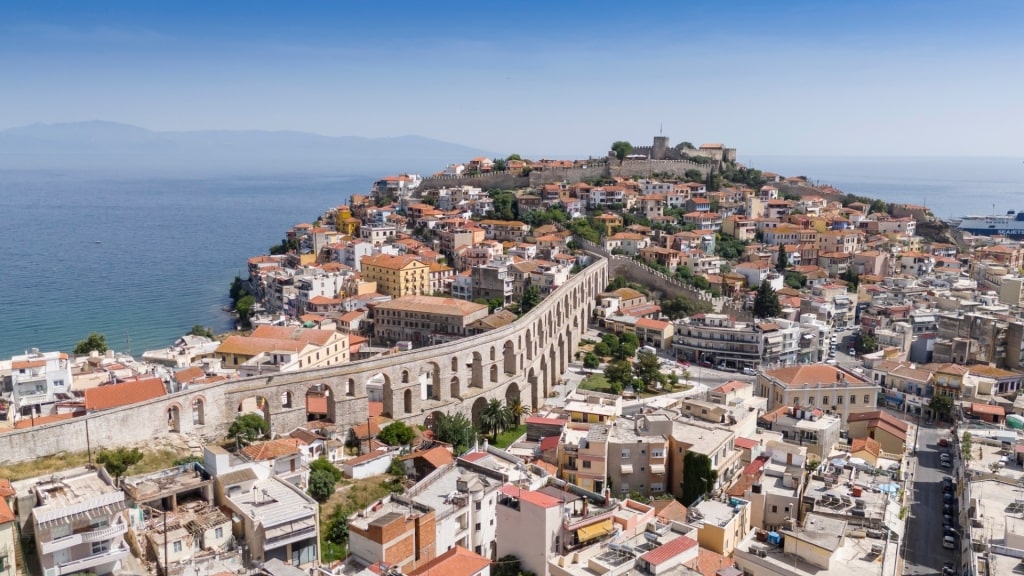
Panagia
More of a peninsula than a quarter, Panagia is the city’s Old Town and one of the main reasons to visit Kavala. With its winding streets and brightly colored old mansions and houses, it’s a delight to explore, packed with sights and topped by the Kavala Fortress.
There’s plenty to do outside of Panagia in the more modern city too, of course. There’s great shopping on both Venizelou and Omonia streets, while pedestrianized Megalou Alexandrou Street is home to the Shopping Mall of Kavala. Housed in a former tobacco warehouse, it’s an elegant setting for the many shops and beauty salons that reside there.
See The Views From Kavala Fortress
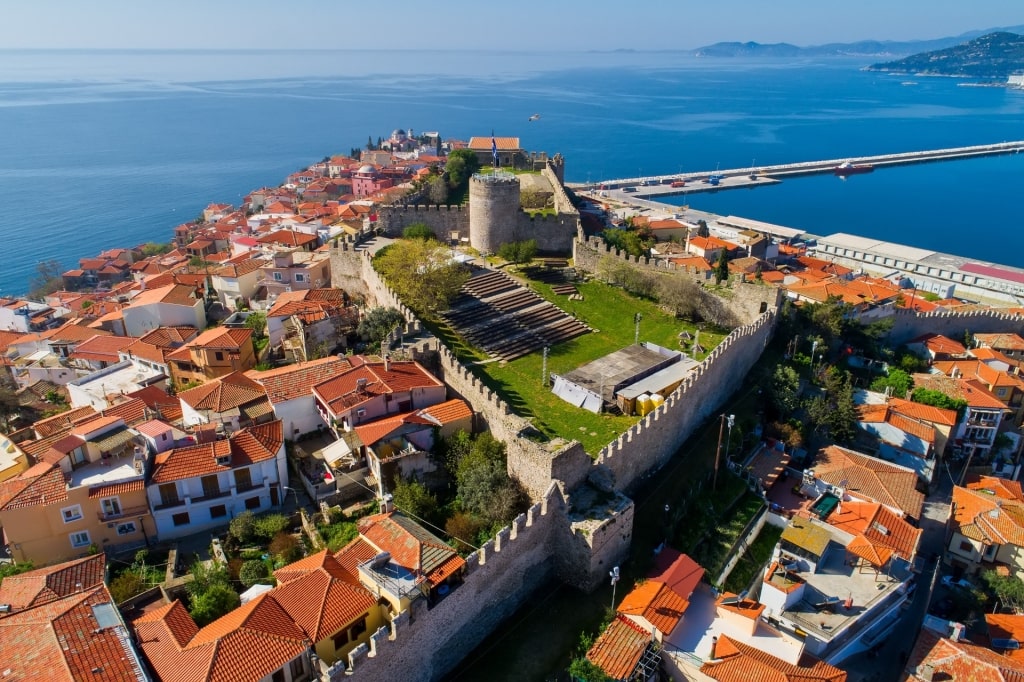
Kavala Fortress
The Acropolis of Kavala dominates the skyline here, a medieval citadel that was designed to protect the valuable and critical Via Egnatia trading route that passes nearby.
On the site of a former fortress that was destroyed in 1391, today it is home to imposing walls, a circular central tower, the former armory, a jail, and incredible views over Panagia and the Gulf of Kavala below.
Marvel at the Imaret
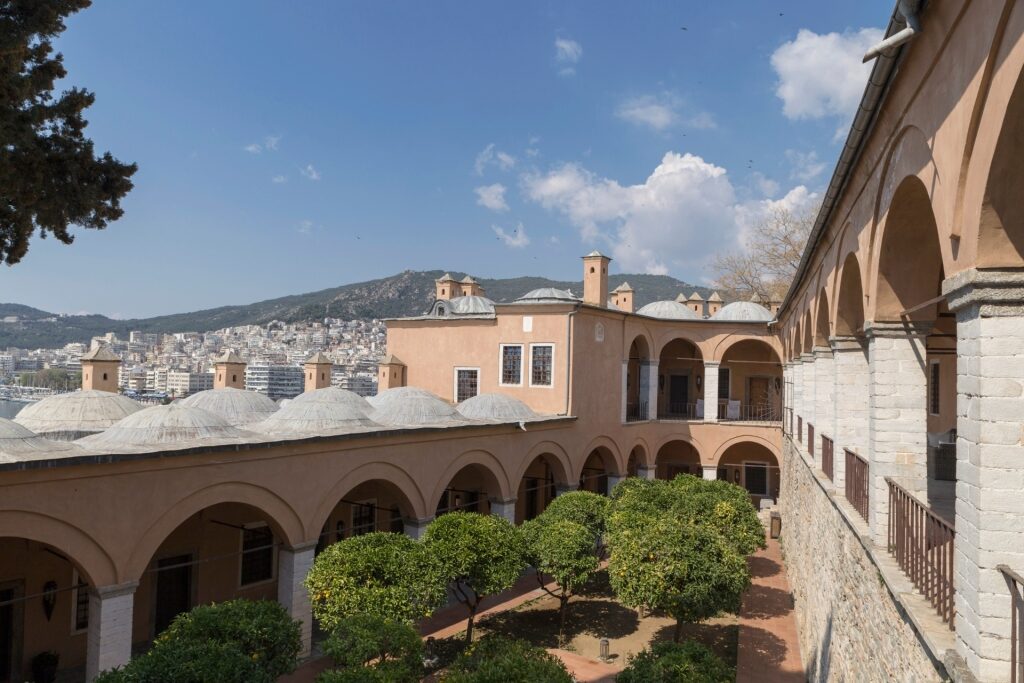
Imaret
The Kavala Imaret was originally a “külliye”—an Ottoman charitable foundation founded by Mohammed Ali Pasha in the early 19th century when the city was under Ottoman rule.
Mohammed Ali is one of the city’s most famous sons, an Ottoman-Albanian born in Kavala who later went on to become a storied general and the founder of modern Egypt.
He built the complex to consist of a madrasa higher education college, a primary school, a soup kitchen, and several water tanks. Today it has been converted into a high-end hotel, but remains one of the city’s most famed landmarks.
Take a Photo at the Kamares Arches
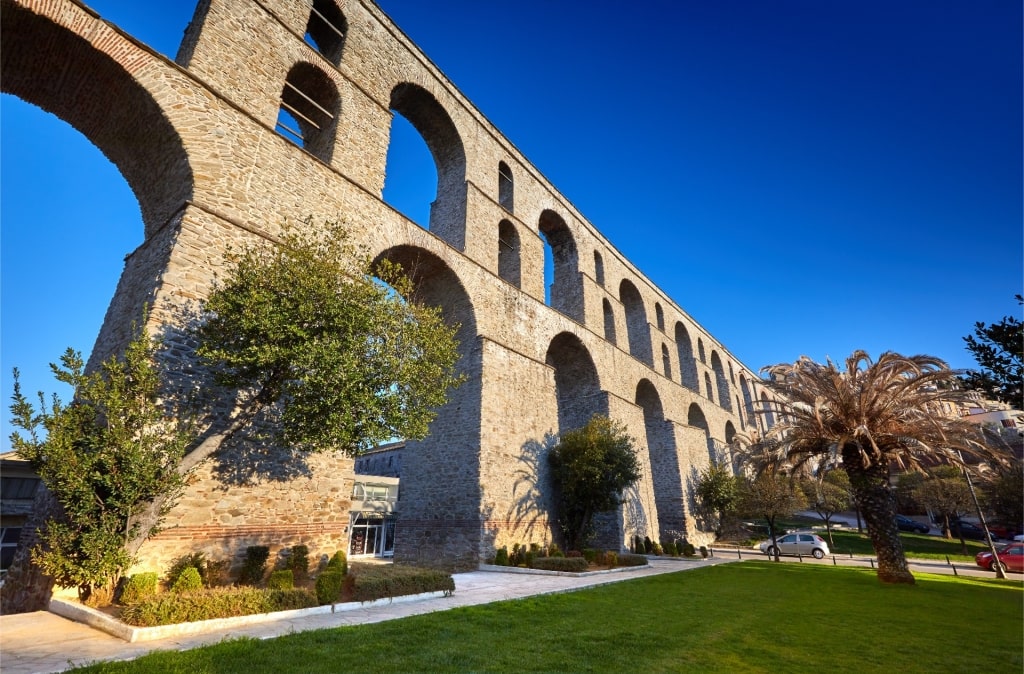
Kamares
At 75 feet high and some 300 yards long, the “Kamares” aqueduct dominates the skyline as one of the city’s most iconic structures. Built in the early 16th century, it helped carry water from surrounding Greek mountains to the formerly arid Panagia peninsula.
Without it, it’s unlikely the Old Town would have existed in its present form. Kamares means “arches” and those self-same arches of this huge structure make for interesting natural photo frames that can be used to create striking images of the city beyond.
Get Historical Insight at Mohammed Ali’s House

Mohammed Ali House Photo by DocWoKav on Wikimedia Commons, licensed under CC BY-SA 4.0
In a square that bears his name, there is both a statue and the former residence of famed son of the city, Mohammed Ali.
His former residence is now considered one of the finest examples of 18th-century Ottoman architecture in Greece and can be visited on a daily basis for an insight into both his life and the history of the city and beyond.
Learn About the Tobacco Industry
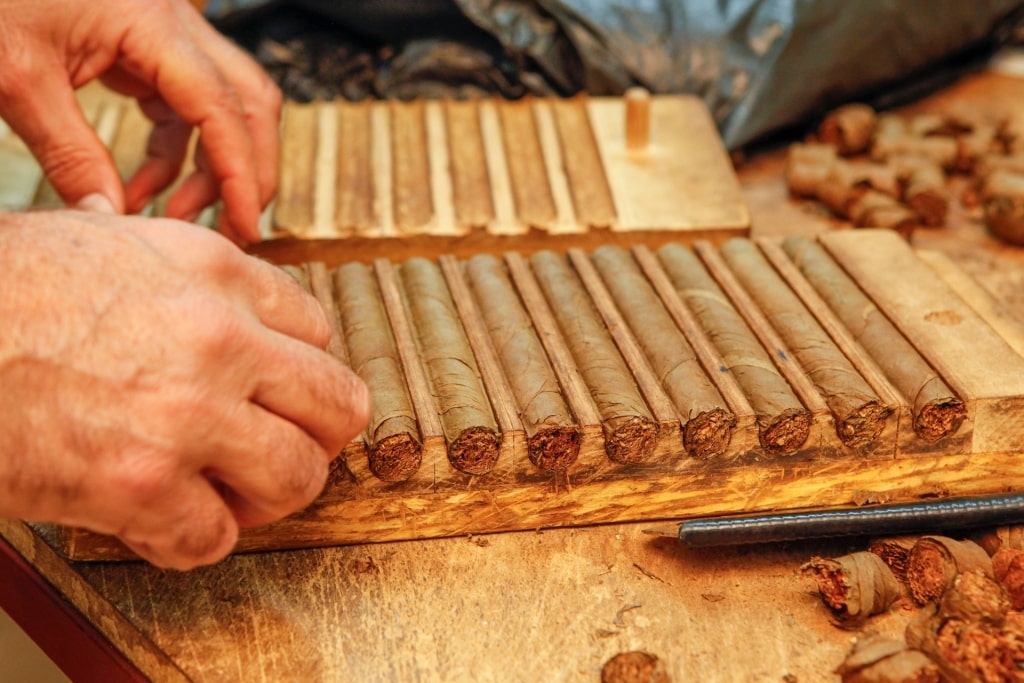
Tobacco
From the mid-19th century until the 1950s, Kavala was the largest tobacco processing center in the Balkans, creating thousands of jobs and bringing much prosperity to the city, creating a Golden Age beyond comparison.
Outside the Old Town on Kapnergati Square sits what was the Municipal Tobacco Warehouse, a fine example of Ottoman neoclassical architecture that now acts as a cultural center. Meanwhile, Palaiologou Street is home to the city’s Tobacco Museum where visitors can get an insight into the industry and its socio-economic effects on Kavala and its surroundings.
See the Exceptional Architecture of the Great Club
In a city of exceptional architecture, the elegant Megali Lesxi, or Great Club, stands a class apart. One of Kavala’s most iconic buildings, it was founded by a women’s charity in 1910 to provide a cultural home for the city’s native Greek population.
Built in the Austrian baroque style, it bears a close resemblance to the Vienna Concert Hall, the Musikverein, and was recently renovated by the city for use as a cultural space.
Hike the Waterway Trail
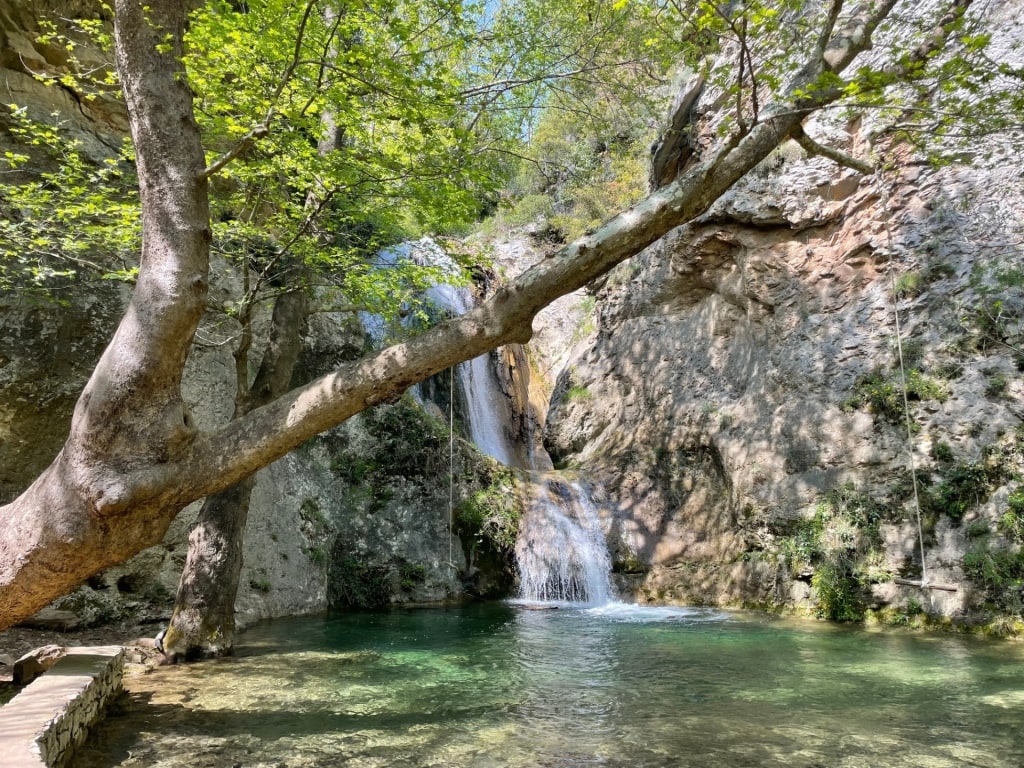
Waterway Trail
This six-mile journey through the surrounding countryside crosses bridges and passes by fountains and cisterns as it follows a centuries-old water route linking the settlement of Palaia Kavala, or Old Kavala, with the city itself.
The first part of the trail is around three and a half miles long and leads to “Mana tou nerou”, a spring that once provided the city’s main source of water. The second section continues to Agios Konstantinos, in the north of the city, before reaching the Old Town. On the way, you will walk past oaks, junipers, elms, and maples.
Read: Best Places to Go Hiking in Greece
See the Archaeological Site of Philippi
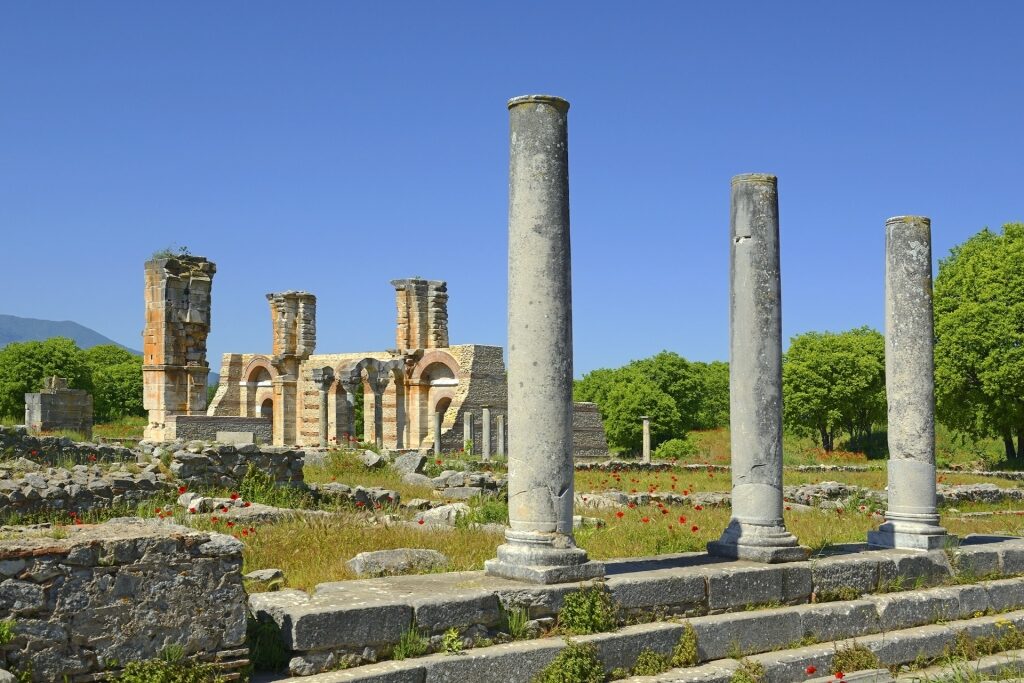
Archaeological Site of Philippi
North of Kavala lies one of Greece’s most important historical sites, that of the ancient city of Philippi. Formerly known as Crenides and one of the greatest population centers of its time, it was renamed in 356 BC in honor of Philip II, King of Macedonia and father of Alexander the Great.
The city’s Roman influences can be seen today in its ruins that feature basilicas, graves, a forum, a theater, and more.
Food & Drink
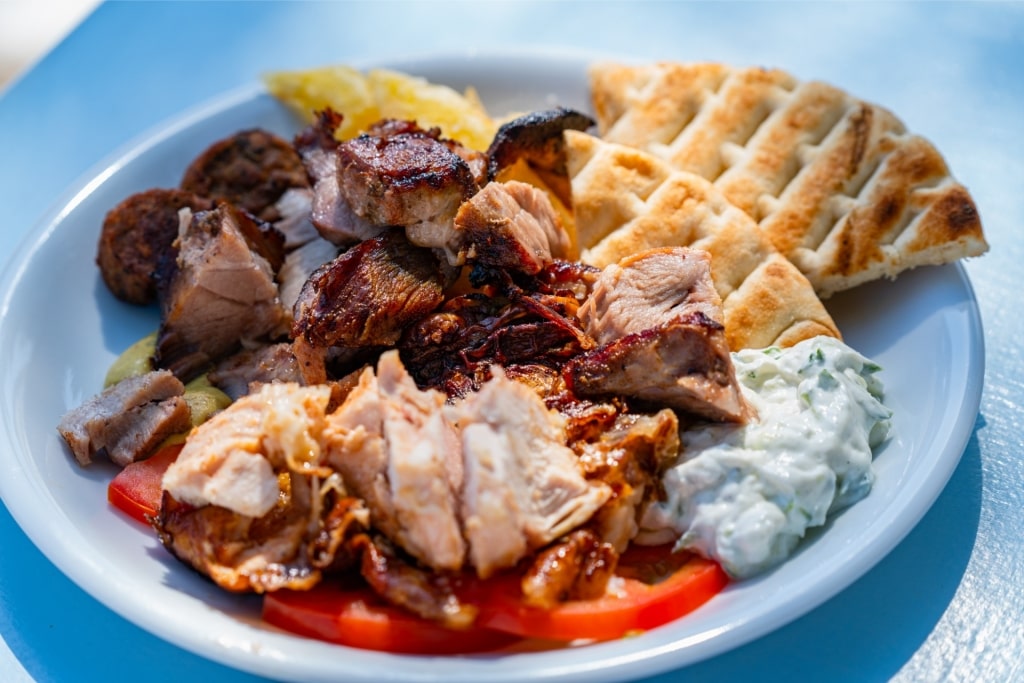
Gyros
Greek food is famed for getting the best out of simple, tasty, and seasonal ingredients and letting the natural flavors take care of themselves.
Tavernas are abundant in Kavala with meals usually consisting of a series of meze small plate starters followed by a main course. Don’t worry—it’s usual to feel full by the time the main course arrives. Just take it slowly like the locals do.
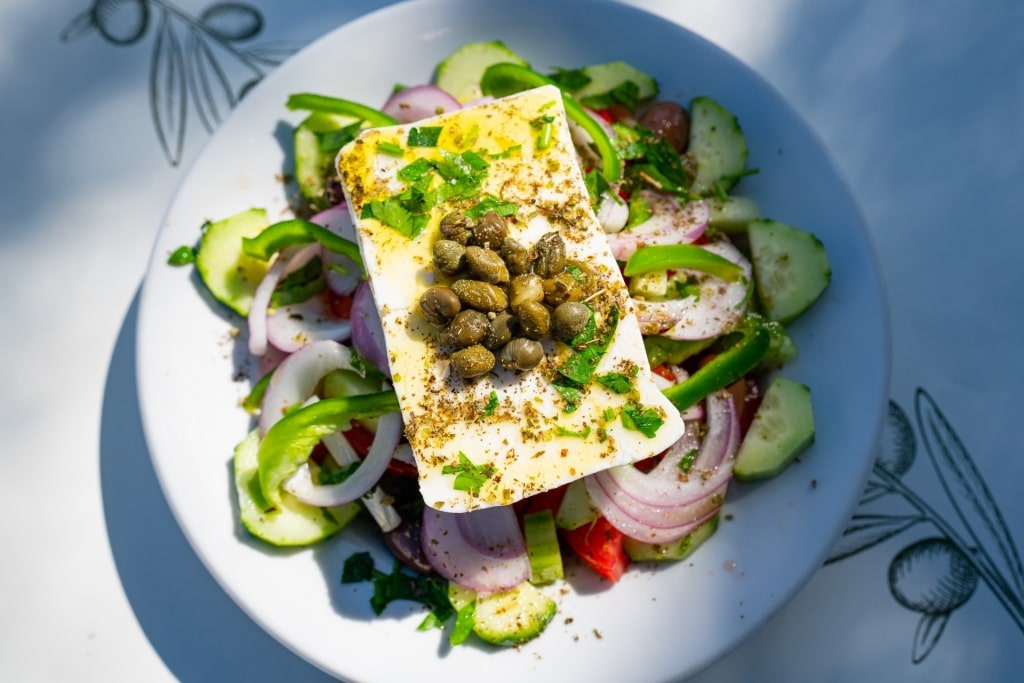
Greek salad
Must-try dishes include Greek cuisine regulars such as tzatziki, a yogurt, cucumber, and garlic dip; Greek salad, topped with crumbly feta cheese; and horta, sauteed mountain greens. Dishes originating here include spiced sardines with rice, and bougatsa, a sweet dessert made with a custard cream.
Greece is known for its wine, and local wines here are good quality and relatively cheap. Meanwhile, the typical fire waters of Greece, ouzo, tsipouro, and raki are all readily available.
Best Time to Visit Kavala
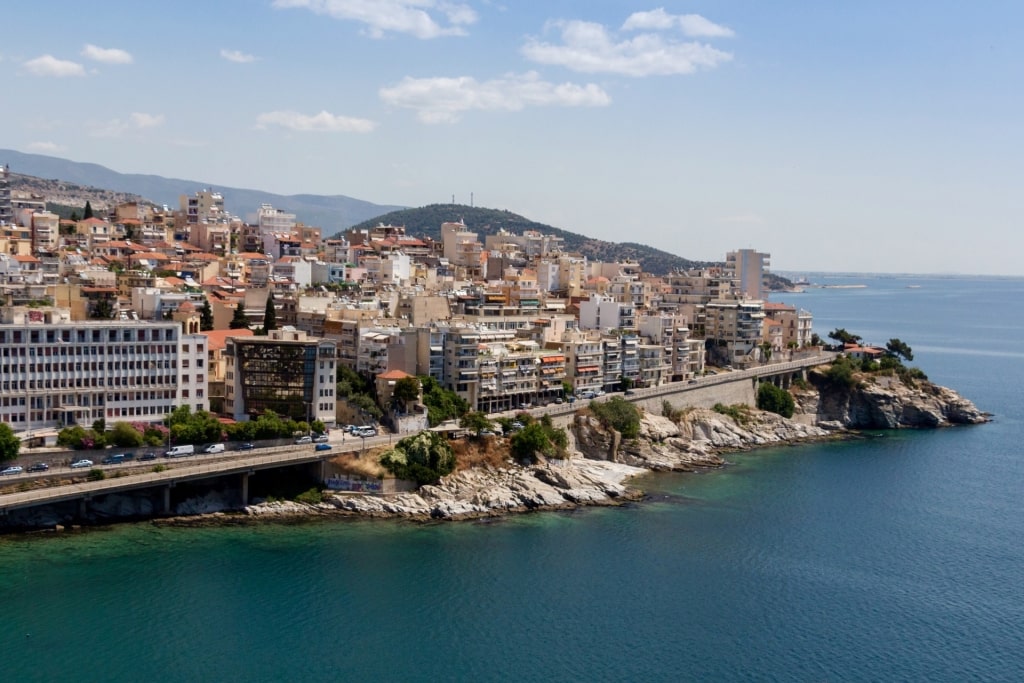
Kavala
The fabulous summer season is probably the best time to visit Kavala. Not only are both the sea and the sun at their warmest, but there’s a lovely buzzy vibe to the place, aided by the wide array of cultural events that take place.
The Festival of Philippi, which lasts from July to September, is a popular highlight. Founded in 1957, it includes theatrical and music performances, as well as exhibitions.
For those looking to avoid the larger crowds of summer, the shoulder seasons are warm and bright, with spring a particularly good time as everything starts to open for summer. Winter is naturally quieter but the city’s status as a university town means there’s still plenty of life in the colder months.
Read: Best Things to Do in Greece
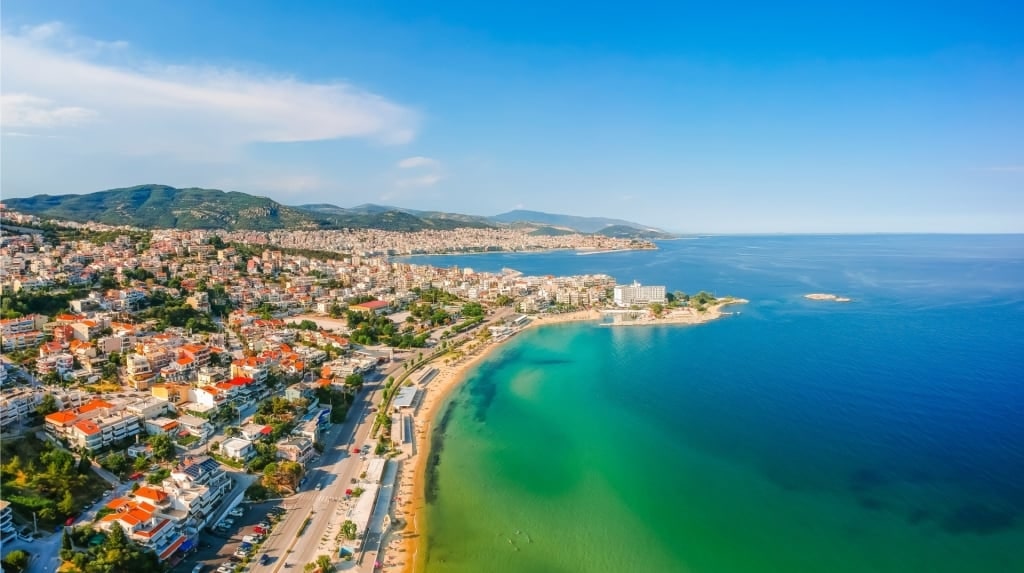
Kavala
Plan your own odyssey on one of Celebrity’s cruises to Kavala and discover the city for yourself.
